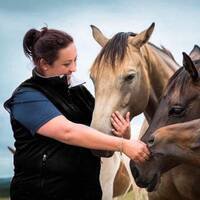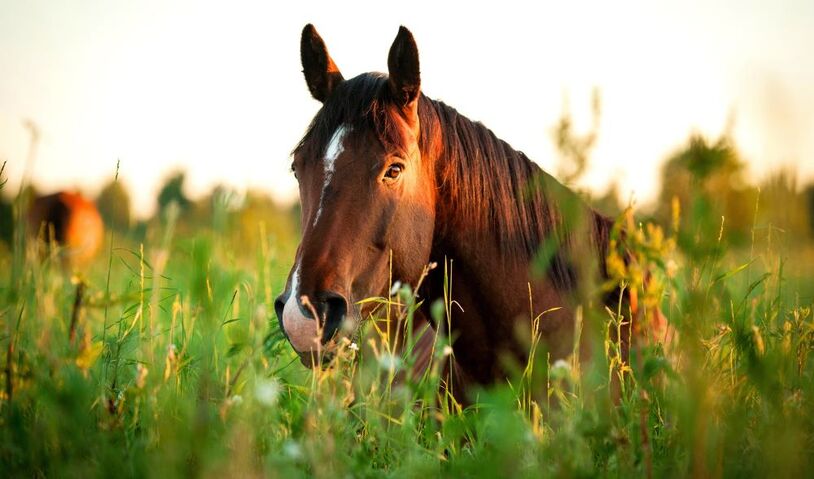Before domestication, horses could be considered browsers rather than grazers. They would cover large distances daily, consuming a variety of forages as they travelled. These forages would have been nutritionally poor but varied, being a mix of grasses, plants and even certain trees and shrubs. Fast forward to today and a large proportion of domesticated horses are managed on sources of nutritionally rich and variety poor forages.
These forages can consist of preserved forages in the forms of hay or haylage, and manufactured available options of hay re-placers, chaffs, and fibre mashes. Forage analysis for hay/haylage has meant that many producers can provide typical nutritional information for their preserved forages. Commercially manufactured forages are legally required to provide information on nutritional content and this information can be found on each bag and should be easily sourced from the relevant company. Knowing the nutritional content, and amounts of these forages fed allows owners and nutritionists to devise a balanced diet suitable for each horse. Unfortunately, knowing the nutritional content of the available grass, or the amounts eaten while a horse grazes, is not so clear-cut. This combined with the sheer volume of misinformation or misinterpretation of information relating to grass and grazing often results in contradictory and confusing advice.
This article aims to address a couple of the most commonly asked grass-related questions, which I hear as an independent equine nutritionist.
Can grass provide everything a horse needs?
Firstly, the nutrients that grass can provide for a horse depend on the richness and quantity of the grass. If the grass is poor or sparse it is likely to be deficient in energy, which would result in a loss of condition and reduced performance. It is also likely to be deficient in several vitamins and minerals, which could result in below-optimum health (figure 1). In this situation, grass alone does not provide everything a horse needs. The diet will likely require supplementation with additional forage sources and a suitable compound feed to provide additional energy, vitamins and minerals.
Figure 1: Poor quality Grass [1] PC Horse
If the available grass is too rich or plentiful, it can provide both energy and total protein in excess of a horse's requirements (figure 2). This would most likely result in unhealthy weight gain and possibly over-exuberant behaviour. Even when the grass is providing certain nutrients above what is healthy, it still fails to provide all the vitamins and minerals at the required level. A change of management would be required to reduce the total grass intake. This can be achieved by several methods including, reducing the size of the field with strip grazing, reducing the time a horse is turned out onto the grass, slowing the rate at which the grass can be eaten with the use of a muzzle, or by significantly increasing the workload of the horse. Irrespective of the choice of management, an additional source of vitamins and minerals would be required to meet all the needs of a horse. These can be supplied in low-energy formulations with field blocks, vitamin and mineral supplements or with low energy balancers.

Figure 2: Rich Spring Grass [1] - PC Horse
Secondly, how close the grass gets to meeting a horse's needs depends on the requirements of that specific horse. Hardworking, underweight, growing horses, or mares in late pregnancy/with a foal at foot, have higher requirements for multiple nutrients (energy, protein and specific vitamins and minerals) than other horses. As a result, grass alone is even less likely to meet all their needs. For overweight or out-of-work horses, grass is more likely to provide certain key nutrients in excess, increasing the risk of obesity and laminitis.
Ultimately, regardless of a horse's body condition, workload, age or breeding status, grass can’t provide a horse with all it needs.
Is long grass safer than short grass?
I often get asked this question by owners of horses who are considered sugar-sensitive or at an increased risk of laminitis. Technically, gram for gram, long grass is lower in nutritional content than short grass. Particularly where sugar, or more accurately, water-soluble carbohydrates (WSCs) are concerned. WSCs are the fructans and simple sugars within the grass that the plant has produced via the process of photosynthesis. In younger (shorter) grass, the WSCs can be significantly greater, and digestibility 25% higher, than it would be for the same grass when older (longer) [2].
However, horses don’t eat percentages, they eat grams or kilograms. When horses are turned out we don’t leave them out till they’ve eaten a certain amount of grass. In reality, we turn them out for a certain amount of time. If we imagine long grass as low sugar, digestive biscuits, and short grass as higher sugar, chocolate biscuits. It is easy to understand how long grass could be mistakenly considered ‘safer’. Unfortunately, it’s not that simple.
Long grass can allow each bite to consist of a large amount of grass. Whereas, short grass can reduce each bite to a small nibble. So if we return to the low sugar, digestive biscuit vs higher sugar, chocolate biscuit analogy. For each hour of grazing a far greater amount of long grass (low sugar, digestive biscuits) could be consumed vs the same amount of time on short grass (higher sugar, chocolate biscuits). Potentially resulting in more WSCs consumed during grazing on long grass than short.
Therefore, in a real-life setting, long grass is not guaranteed to be ‘safer’ for a sugar-sensitive horse, and in some situations, long grass could even be considered less suitable. Regarding this group of horses, you must monitor weight changes to prevent excessive body condition and manage grazing to control total intake. If you are unsure of the suitability of your horse's diet, speak with an equine nutritionist. If you have any concerns regarding your horse's body condition, sugar sensitivity or overall health, please speak with your vet.
References
[1] PC Horse. https://pchorse.se/
[2] Geor, R.J., Harris, P.A., Coenen, M. 2013. Equine applied and clinical nutrition, health welfare and performance. Saunders Elsevier Ltd 332-335







